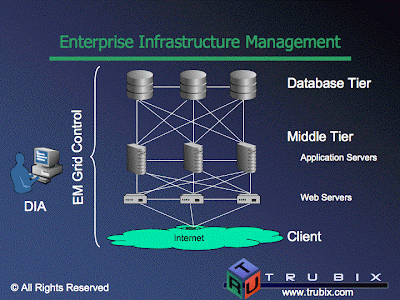Enterprise Infrastructure Management and the Database Infrastructure Administrator

Enterprise Infrastructure Management (EIM) or the management of all the technology stacks across the database and middle tiers is now the challenge facing organizations. If Internet users are now accessing the database through middle tier applications, then anything that impacts the middle tier now impacts data availability.
If something goes wrong or performance is slow where does someone go to find the problem. Organizations that need to manage multiple databases, running in an n-tiered environment now need the ability to manage the entire infrastructure through all tiers. There has always been a separation of duties between databases, operating systems, networks and the middle tier. However during trouble shooting someone needs to understand where to go look in the entire infrastructure. This person needs the skills of a Database Infrastructure Administrator (DIA). The database infrastructure administrator is someone that can trouble shoot the database and the application server environment. Since J2EE applications are deployed in the middle tier, this DIA needs to at least be knowledgeable with the database and middle tier environments.
DIAs are going to be in extremely high demand in the next few years. It is this type of person who is going to be able to maintain high availability environments. This person is going to need to understand complex database environments as well as understand the middle tier. DIAs that understand applications such as PeopleSoft, JDEdwards, Sieble, EBusiness Suite, BI and Oracle Fusion applications are going to be in especially high demand.
The environments are becoming too complex for individuals to write scripts to manage and monitor databases, operating systems, application servers and applications. Software is quickly becoming the solution for efficient organizations.
Database management software from companies like Oracle, Quest and CA are being used to manage multi-database environments. Oracle's Enterprise Manager Grid Control is a software tool for managing the entire Enterprise Infrastructure. It is this Enterprise Infrastructure Management that is going to be a key for managing Oracle 10g and 11g environments. Grid Control also supports the management of the middle tier running the Oracle Application Server. Grid Control supports plugins for SQL Server, DB2, WebSphere and WebLogic but it is the Oracle database and application server environment where Grid Control excels.
Lets look at the Enterprise Infrastructure from three perspectives:
Traditional Oracle Perspective:
- Oracle Database Servers (Streams, Data Guard, RAC, RMAN, ...)
- Oracle Application Servers (application tier, web tier and respository)
- Applications
- Database High Availability Environment (RAC, Data Guard, Streams, ...)
- Oracle Fusion Middle ware (application server, web tier and repository)
- (Oracle Fusion applications)
- Database Tier (Oracle, DB2, SQL Server, ...)
- Middle Tier (Oracle Application Server, WebLogic, WebSphere, JBoss, Apache, ...)
- Applications (Oracle Fusion, EBusiness Suite, JD Edwards, Siebel, PeopleSoft,...)
Oracle Grid Control is going to play a strong role in the enterprise management of Oracle database and Oracle Fusion middle ware environments. The following components are now going to need to be managed across the entire enterprise infrastructure:
- Security (Data Vault, Audit Vault, Identity Management)
- Backup and Recovery
- Performance


2 Comments:
The high avaiability offered by the Oracle Grid solution requires a new paradigm to DBAs´s work environment because the management of this resource needs to be split in different roles. How is your experience of implementation of policies to govern this environment?
In my organization we have gotten some problems to define the rights&responsabilities of instance DBAs and cluster DBA.
Thank you.
Marisa
The dynamics of managing ASM, is definitely a transition for DBAs, storage management teams and system administrators. The transition your team is going through is typical of a lot of environments.
Its very easy to create disk groups for a few devices, and the Oracle documentation makes it look very easy. However, for enterprise environments, understanding how to layout the disk groups, making sure how devices are spread across controllers for mirroring, how to set the characteristics of disk groups is more involved than creating a disk group with a few devices.
The successful environments are blending the skills of the storage management teams/SAs and the Oracle DBAs. In large environments it is important for whoever is going to managing the ASM instance, needs to have a solid understanding of storage and how to best configure the disk groups, striping and mirroring for Oracle databases. Having just pure DBA skills or storage management skills are not sufficient.
For large environments successful ASM management blends the skills of storage management and Oracle database knowledge. This starts with each side understanding the importance of all teams working together (I realize this is easier said than done). Having a production DBA take on the storage management of ASM is not trivial in large environments. Whoever takes on ASM needs to take on the responsibility for managing all the storage management issues associated with ASM. If it is a small environment it is not as difficult for a DBA to take on the storage management of ASM.
People who acquire skills in ASM are going to be in high demand for awhile. Best of luck with your environment.
Post a Comment
<< Home